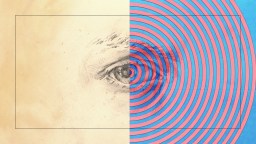MICHELLE THALLER: Mathematics is in some ways kind of scary in how useful it is at really describing how the universe works around us. Now, I mean to give you an idea, the origin of mathematics seems very straightforward. We can count on our fingers up to ten and maybe it was useful to understand how many sheep you had so you could start counting sheep. And then you either added or subtracted sheep as you got more or as you lost some. It was a simple thing. We learned how to count. We learned how to add and subtract. The idea of multiplying and dividing is a little more abstract but that also makes sense. That's something that we can kind of visualize. But then what amazes me is that this led us on a tremendously complicated journey that's still going on to this day and we had no idea where this would lead us.
EDWARD FRENKEL: It's a very unfortunate situation when you can't even begin a conversation about mathematics without people saying 'Oh, my gosh. I don't want to talk about it.' And it's kind of strange because no one would ever say 'I hate literature' or 'I hate art' or 'I hate music.' At least, intelligent people would never say that. It's kind of shameful to say that. But it's perfectly okay in our society to say 'I hate mathematics.' And so what I dream of is a society in which it's not that everyone has a Ph.D. in mathematics, but rather I would like to live in a society in which if mathematics is brought up someone would say 'Oh, mathematics. Interesting. How do I find out more? Can you give me a gist of the idea?' I'm not scared of it. I'm curious about it, the way I'm curious about the solar system, about the atoms and the DNA. All these things which are in our collective consciousness, in our public discourse, which are no simpler than mathematical concepts. Mathematical concepts are no more complicated than these concepts in physics and biology that are in the air, that are what we are aware of. So I would like people to be aware of this, of these mathematical ideas. I'd like them to be more and more aware of how mathematics invades our lives. How it's controlling our lives.
MICHIO KAKU: In the 1600s, Isaac Newton asked a simple question: If an apple falls, then does the Moon also fall? That is perhaps one of the greatest questions ever asked by a member of homo sapiens since the six million years since we parted ways with the apes. If an apple falls, does the Moon also fall? Isaac Newton said yes, the Moon falls because of the inverse square law, so does an apple. He had a unified theory of the heavens, but he didn't have the mathematics to solve the falling Moon problem. So what did he do? He invented calculus. So calculus is a direct consequence of solving the falling moon problem.
PO-SHEN LOH: I do think that everyone in America could benefit from having that mathematical background in reasoning just to help everyone make very good decisions. And here I'm distinguishing already between math as people usually conceive of it and decision making and analysis which is actually what I think math is. So, for example, I don't think that being a math person means that you can recite the formulas between sins, cosines, tangents and to use logarithms and exponentials interchangeably. That's not necessarily what I think everyone should try to concentrate to understand. The main things to concentrate to understand are the mathematical principles of reasoning.
FRENKEL: And I understand why people are scared and frightened. It's not their fault. It's because of how mathematics is taught in our schools.
LOH: I think that actually one reason mathematics is difficult to understand is actually because of that network of prerequisites. You see, math is one of these strange subjects for which the concepts are chained in sequences of dependencies. When you have long chains there are very few starting points. In mathematics you have very few that you memorize and the rest you deduce as you go through. And this chain of deductions is actually what's critical. Now, let me contrast that with other subjects like say history. History doesn't have this long chain. In fact, if you fully understand the War of 1812 that's great and it is true that that will influence perhaps your understanding later of the Women's Movement, but it won't be as absolutely prerequisite. In the sense that if you think about the concepts, I actually think that history has more concepts than mathematics, it's just that they're spread out broader and they don't depend on each other as strongly. Math has fewer concepts but they're chained deeper. And because of the way that we usually learn, when you have deep chains it's very fragile because you lose any one link meaning if you miss a few concepts along the chain you can actually be completely lost. Now, I think that the way to help to address this is to provide a way for everyone to learn at their own pace and, in fact, to fill in the holes whenever they are sensed. I actually feel like if everyone was able to pick up every one of those prerequisites as necessary filling in any gap they have, mathematics would change from being the hardest subject to the easiest subject. So after thinking for some time I actually came to an idea which was based on using these core mathematical areas that I had been working with to actually build a solution for education that could be delivered for free on every smartphone. This is actually the project that I'm working on right now called Expii. Our principle is that actually you could turn that smartphone into a virtual tutor which automates what a person would get if they hired a tutor. It's not that the class comes first and then the homework and then the exam. The first thing that comes is the exam essentially followed by these practice problems which adapt to you, followed by the class for anything that you don't know. The idea is that this should cure boredom at the high end and also cure confusion at the struggling end.
KAKU: Some people ask the question of what good is math? What is the relationship between math and physics? Well, sometimes math leads, sometimes physics leads, sometimes they come together because, of course, there's a use for the mathematics.
JANNA LEVIN: As a theoretical physicist I rely very much on calculating to understand results. So let's say I want to know what happens when a big black hole swallows a little tiny black hole. My starting point will be to think what's my first mathematical sentence that I know if I crack it open will answer this question? Now even that step can be very hard. And then once I do that I'll be moving in a very structured way through the steps to unlock that. When I work with much younger students I like to kind of sit back in the room when we're calculating now and ask them to try to find the solution in the way that we do know how to go one step after another, but I'll be trying at the same time to try to find that cute way of unpacking it that's highly non-obvious. And sometimes I'm sitting there for two days while they're generating 12 pages of very tough, beautifully done calculations where I'm trying to find a way to try to do it in a half a page. And sometimes I succeed and sometimes I don't. Sometimes I can't do that. It's just not possible or I haven't figured out how to do it. And sometimes I do. And when you do it's not just that it's shorter, it's that you're working with such bigger structures that you can see so much more at a time.
KAKU: Then here comes Einstein asking a different question and that is: What is the nature in origin of gravity? Einstein said that gravity is nothing but the byproduct of curved space. So, why am I sitting in this chair? A normal person would say I'm sitting in this chair because gravity pulls me to the ground. But Einstein said no, no, no, no. There's no such thing as gravitational pull. The earth has curved this space over my head and around my body so space is pushing me into my chair. So to summarize Einstein's theory: Gravity does not pull. Space pushes. But, you see, the pushing of the fabric of space and time requires differential calculus. That is the language of curved surfaces, differential calculus, which you learn in fourth-year calculus. So again, here's a situation where math and physics were very closely combined but this time math came first. The theory of curved surfaces came first. Einstein took that theory of curved surfaces and then imported it into physics.
THALLER: If you can do multiplication and subtraction it's not too long before you begin to develop the basic building blocks of calculus. And calculus describes how moving objects can change, how things can accelerate. If you want to describe an apple falling from a tree to the ground or a ball rolling down a hill, that's calculus. It's the mathematics of how things can change over time. That's really interesting and the amazing thing is it works so well. If you use these equations to predict how a ball will roll down a hill, reality matches that. It really does tell you how something is going to behave. So now we've gone from counting on our fingers how many sheep we have to being able to predict what the universe around us is going to do. That's incredibly powerful.
GEOFFREY WEST: Just taking mammals, that the largest mammal, the whale, is in terms of measurable quantities, that is of its physiology and its life history, is actually a scaled-up version of the smallest mammal which is actually the shrew but a mouse is very close to that and everything in between, but they are scaled versions of one another. The most well-known of these is the scaling of metabolic rate and metabolic rate is maybe the most fundamental quantity of life because metabolic rate simply means how much energy or maybe just how much food does an animal need to eat each day in order to stay alive. And everybody's used to that and is familiar with that, it's sort of roughly 2,000 food calories a day for a human being. So you can ask what is that for different mammals? And what you find is that they're related to one another in a very simple way despite the fact that metabolism may be the most complex physical chemical process in the universe, for all we know. It's phenomenal, because metabolism is taking essentially something that's inorganic and making it into life. So here's this extraordinary, complex process and yet it scales in a very simple way and you can express it in English—you can express it quite precisely in a very simple mathematical equation—but in English, it's roughly speaking that every time you double the size of an organism from say two grams to four grams or from 20 grams to 40 grams or 20 kilograms to 40 kilograms or whatever, just doubling anywhere, instead of what you might naively expect, double the size, double the number of cells, roughly speaking, therefore you would expect to double the amount of energy, the amount of metabolic energy you need to keep that organism alive because you have twice as many cells. Quite the contrary, you don't need twice as much. Systematically, you only need, roughly speaking, 75 percent as much. So there's this kind of systematic 25 percent, one-quarter, savings. And it turns out that anything else you measure, as I mentioned a moment ago, scales in a similar way with this sort of 25 percent rule occurring in some interesting way. The same mathematical—and this is extremely important—the same mathematical and physical principles apply to a mammal, which has a beating heart, as applies to a tree. And a mammal, our circuitry system is a bunch of tubes like in your house, the plumbing in this building we're sitting in, that's our circulatory system. But a tree and a plant, they're not like that. They're a bunch of fiber bundles kind of joined together like electrical cables that spray out and that's what you see when you see a tree. But even though they—and they don't have beating hearts, as we well know. And yet they satisfy the same mathematical principles and those mathematical principles give rise to this quarter-power scaling in mammals, but also in plants and trees, but also in fish and birds and crustacea, in principle, and insects and so on, and that's the idea.
THALLER: Now we look around us and we see things like planets orbiting the stars or the galaxy turning around and we realize those equations of motion apply to everything else in the universe. It's not just here. It's not just on the surface of the earth, but we can look at things literally billions of lightyears out in space and they're following those same rules of mathematics. So we keep getting led farther and farther down this rabbit hole. Where does math lead us? Now we realize that you can describe physics incredibly well if you allow the universe to exist in many different dimensions, more than the three dimensions that we're familiar with. In fact, specifically if you want to do particle physics it requires 11 dimensions. That's not something our minds comprehend but we can do the math. We can do the math of how things would behave if they could move in 11 different directions. And it turns out to predict exactly the results we get from particle physics. That's kind of scary. Does that mean that's real? Are there really 11 dimensions? The math works so well and the predictions are so strong that it can't just be nonsense. But now we've gone to the limit of what I can tell you: Is it real or not? Our math has given us something incredibly useful, but it's taken us completely out of our realm of common sense, of human scale, of how our minds work and even our sense of space and time. I don't think that journey's over yet. Where is math going to lead us? It may lead us to understand things like the universe is a type of a hologram. That was a mathematical solution to how things work around a black hole and it works really, really well. So, I think it's wonderful and a little bit scary that you start counting on your fingers, you get to 11 dimensions of space and time and where else?






